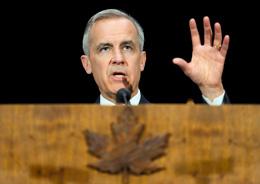Carney Must Walk Immigration Tightrope With Minority Mandate

Analysis
Mata Press Service
As the dust settles over Canada’s historic 2025 election, a new chapter in immigration policy is poised to be written by Prime Minister Mark Carney, one that promises to balance economic ambition with political pragmatism, and compassion with control.
But will it?
With a minority mandate, mounting public pressure, and unpredictable cross-border dynamics, Carney’s immigration agenda may prove less like a blueprint and more like a balancing act, where success will hinge not on lofty ideals but on hard results.
Carney takes office at a time when immigration, long seen as a cornerstone of Canada’s prosperity, is now also a lightning rod for debate.
Soaring housing costs, creaking infrastructure, and strained public services have collided with record-high levels of newcomers. The question facing Carney isn’t just how many people Canada can welcome but how well it can support them once they arrive.
At the heart of the Liberal immigration platform is a promise to stabilize permanent resident (PR) admissions at less than 1% of Canada’s population beyond 2027.
It’s a notable pullback from the Trudeau-era targets that aimed for half a million new PRS annually by 2025.
Instead, under the current plan, PR admissions will taper from 395,000 in 2025 to 365,000 by 2027—figures that reflect a deliberate effort to align immigration intake with available housing, healthcare capacity, and employment opportunities.
The move may reassure a public increasingly wary of rapid growth.
A recent Angus Reid poll showed a majority of Canadians now support reduced immigration levels, citing affordability and service access as primary concerns.
Yet, this new stability comes with trade-offs for potential immigrants and the industries that rely on them. More predictability, but also tighter competition and slower expansion, especially in sectors hungry for skilled labour.
If permanent residency levels are being eased down gently, temporary immigration is facing a sharper recalibration.
As of January 2025, Canada’s three million temporary residents accounted for more than 7% of the total population. Carney’s government has vowed to bring that down to below 5% by 2027.
That means fewer international students, more restrictive rules for foreign workers, and a tougher road for spouses seeking open work permits.
“We can’t outpace our ability to house and support people,” Carney argued during the campaign, justifying ongoing caps and eligibility changes introduced in the final Trudeau years.
While the government says it will prioritize transitions from temporary to permanent status, that’s cold comfort to those already stuck in limbo, especially students and workers caught mid-way through pathways that have now shifted.
Still, the Liberals’ plan allocates nearly 83,000 PR spots in 2025 for individuals already in Canada, signalling a shift toward "status for those already here" over new inflows.
One area that will see expanded intake is francophone immigration outside Quebec. The Liberals are ramping up targets from 8.5% in 2025 to 12% by 2029 in a bid to bolster minority French-speaking communities in Ontario, New Brunswick, and beyond.
For Carney, it’s a way to support linguistic diversity and address labour gaps in underserved regions, all while steering clear of Quebec’s political sensitivities.
Expect increased funding and outreach under programs like the Francophone Community Immigration Pilot.
Despite a more cautious tone, Carney isn’t closing the door on skilled immigration. Economic class immigrants will remain the largest share of permanent admissions, 62% by 2027.
The revamped Global Skills Strategy is set to speed up processing for in-demand roles, especially in tech and trades. And the government has committed to working with provinces to streamline foreign credential recognition, a long-standing bottleneck in sectors like healthcare.
Carney’s pitch: Canada still wants global talent—but with faster integration and better alignment to labour market needs.
No immigration policy can be written in isolation, especially with Donald Trump back in the White House.
Trump’s aggressive enforcement tactics and fast-track deportations have renewed scrutiny of the Canada-U.S. Safe Third Country Agreement, which assumes both countries offer fair refuge for asylum seekers. Critics say that’s no longer true, and irregular crossings into Canada are already rising.
Carney has promised “closer collaboration” with U.S. authorities, but what that means in practice remains unclear. With 281,000 refugee claims still pending, Canada’s system is already overloaded, and further spikes could force Ottawa into a reactive posture.
To manage the system better, Carney’s Liberals are betting on digital modernization to cut processing times and clear backlogs. But the department still faces staffing cuts and infrastructure gaps that could blunt those gains.
Legal aid for asylum seekers will be expanded, a move the Liberals say ensures fairness while expediting decisions. Enforcement will also tighten. Failed claimants will be removed more swiftly, and visa processes will face new scrutiny to prevent fraud.
Yet critics argue that while these tweaks sound strong on paper, many have been promised before. Execution, not design, will determine whether this reset sticks.
Canada’s immigration challenges are not unique, but they are pressing. A shrinking workforce and aging population make immigration essential. Yet housing shortages, rising rents, and healthcare delays have turned it into a flashpoint.
Carney’s plan tries to thread this needle: moderate intake, better integration, stricter controls. But in a minority Parliament, with opposition parties eager to exploit public fatigue, every policy move will face intense scrutiny.
Carney has vowed to govern for all Canadians. That includes newcomers looking for opportunity and longtime residents demanding relief.
Whether his immigration blueprint delivers on both fronts may decide not just his legacy, but the shape of Canada for decades to come.









